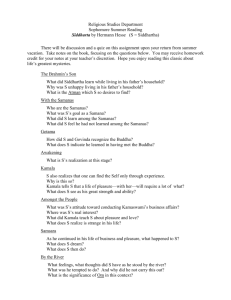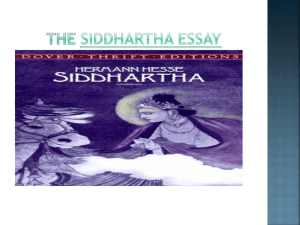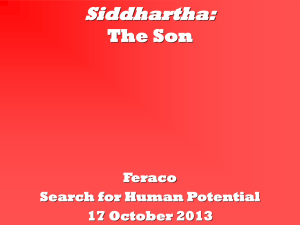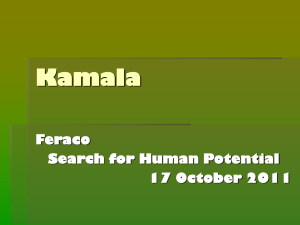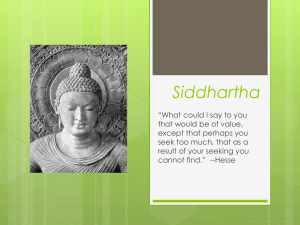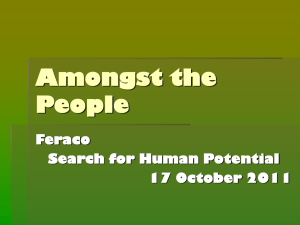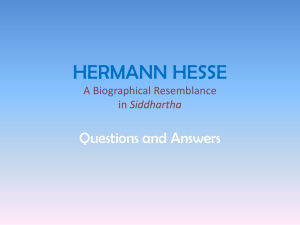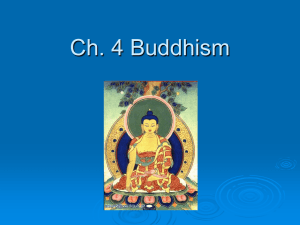With the Samanas - AUSD Portal
advertisement
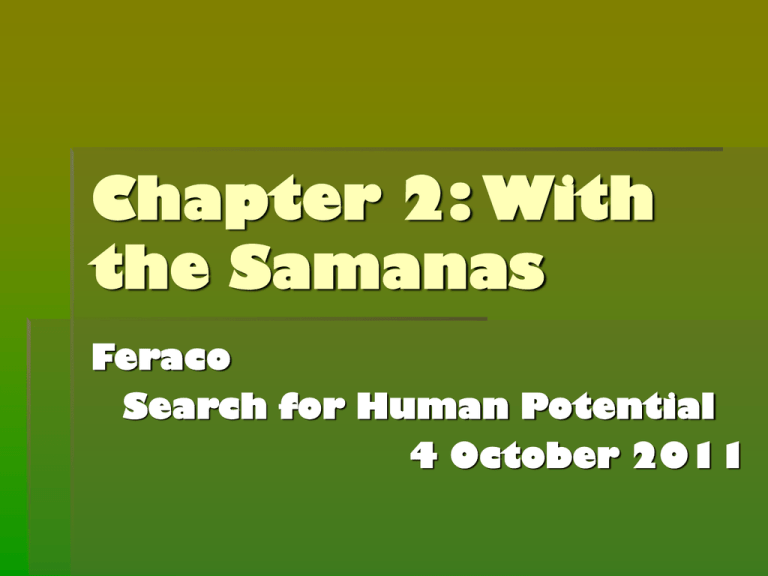
Chapter 2: With the Samanas Feraco Search for Human Potential 4 October 2011 First Glimpses Siddhartha’s first experience with life outside his home is reminiscent of Gotama’s impression of the rest of the world – those first glimpses of pain, deprivation, and struggle The difference is that Gotama was moved, while Siddhartha claims that “all were not worth a passing glance, everything lied, stank of lies; they were all illusions of sense, happiness and beauty. All were doomed to decay. The world tasted bitter. Life was pain.” Purity is his goal…but should we chase perfection? Aren’t we just guaranteed to suffer if we seek something we can’t reach? Cure vs. Disease In his doomed effort to chase perfection, Siddhartha suffers intensely Sometimes the cure is worse than the disease Siddhartha’s body decays – graphically – over the course of three years as he tries to shatter the Self He saves everything – even his breath Trying to suffocate the Self in order to reach the truth behind it He has the “right idea” (i.e., looking behind the veil) mixed in with a whole lot of wrong Muddled Visions A lot of what happens in the second chapter follows that pattern – hints of what should be happening drowning in seas of misdirection The moment where his soul is basically bopping from body to body is another example The visions Siddhartha has represent the Samsara cycle he’s still trapped in – and he doesn’t quite see it, at least not at first There’s a dim understanding of unity at work here in his attempts at escape, but he’s so caught up in himself and his “onerous life cycle” that he doesn’t consciously understand what’s happening to him Sloughing Off Teachers We see on the chapter’s second page that he’s being instructed by the eldest Samana Wasn’t it only a few paragraphs ago that Siddhartha was all anti-teacher? But we soon see him questioning the Samanas’ methods and teachings, just as he challenged the elders in his village He bemoans the temporary nature of his escape (remember this) Once again, no one seems to know the way to reach what Siddhartha seeks Remember, he distrusts teachers because many of them haven’t achieved what they’re trying to teach others to do Intoxication I When Govinda defends the Samanas’ methods, he and Siddhartha begin discussing the futility of their search in terms of intoxication You speak thus, my friend, and yet you know that Siddhartha is no driver of oxen and a Samana is no drunkard. The drinker does indeed find escape, he does indeed find a short respite and rest, but he returns from the illusion and finds everything as it was before. He has not grown wiser, he has not gained knowledge, he has not climbed any higher. I do not know. I have never been a drunkard. But that I, Siddhartha, only find a short respite in my exercises and meditation, and am as remote from wisdom, from salvation, as a child in the womb, that, Govinda, I do know. Intoxication II Intoxication is a really easy metaphor It’s the willing surrender of control to corruption, a substitution of poison for experience, an inherently empty, sad, and self-destructive pursuit In other words, it’s one of the ultimate expressions of desire’s relationship to suffering: there is nothing to gain from drunkenness but false escape It is too easy This, in turn, is one of the reasons why Hesse shows Siddhartha drinking so heavily in the “Samsara” chapter; he poisons himself because he leads a poisoned life We find consolations, we learn tricks with which we deceive ourselves, but the essential thing – the way – we do not find. Stagnation He’s getting faster – it took about eighteen years to flee the Brahmins, and only three to ditch the Samanas If the forest is about stagnation – a kind of self-inflicted torment – the Samanas’ lifestyle is about another kind entirely The idea driving the Samanas’ actions is a simple one: human life is filled with desire, and that desire causes suffering If one burns away one’s own humanity – becomes uncivilized, denies the body what it wants, etc. – one could, in theory, stop wanting, and consequently look beyond the blindness caused by living as one’s flawed Self Piercing the veil – moving through Maya and into Satyam The Flaw in the Plan The Samanas’ approach is particularly flawed because it contains a fundamental contradiction In order to continue existence as a Samana, one must violate its credos daily One must stop asceticism in order to eat at some point, to sleep at others Not wanting something you can’t have is one thing; is denying yourself what you can have analogous? The clear implication is that life is not compatible with the Samana way – a big hint that either their outlook is mistaken or that they’re going about things incorrectly Take Control What remains from all that seems holy to us? What remains? What is preserved? The Samanas’ principles of asceticism – compared unfavorably to the “drunkard’s” actions – only prove that one cannot flee the unavoidable It’s important to take control, not to simply hide At one point, Siddhartha wonders aloud whether he’s still “trapped in the cycle” Spiraling Well, Govinda, are we on the right road? Are we gaining knowledge? Are we approaching salvation? Or are we perhaps going in circles – we who thought to escape from the cycle? We have learned much, Siddhartha. There still remains much to learn. We are not going in circles, we are going upwards. The path is a spiral; we have already climbed many steps. They’re definitely spiraling…but they’re heading downwards, not upwards Every day spent on the wrong path is a day further removed from enlightenment (although it must be pointed out that these experiences, futile as they may seem, do prove critical to Siddhartha’s eventual success) The World Was Sick Gotama’s introduction here is presented in terms of plagues and cures – an interesting choice, given his real personal history. The world was sick, life was difficult and here there seemed new hope, here there seemed to be a message, comforting, mild, full of fine promises. And here’s a little hint for the future: He had heard that this alleged Buddha had formerly been an ascetic and had lived in the woods, had then turned to high living and the pleasures of the world, and he held no brief for this Gotama. Eagerness and Wariness Govinda, always easily distracted by the prospect of something better, grows eager to meet Gotama after hearing from those who have witnessed him work When Siddhartha mocks him for straying from the Samanas’ path so readily, Govinda says he’s merely curious about the teacher Everything goes in cycles: Siddhartha believes he has “already tasted the best fruit” of Gotama’s teachings, but he’s also aware that he’s started stagnating again in the Samanas’ world Once again, a leader is displeased with Siddhartha’s intended departure, and Siddhartha simply defeats him (through the strength of his will and desire, ironically enough) Knowledge and Experience The elders themselves may be unable to give Siddhartha what he wants or needs – but it’s important to remember that he doesn’t want to be given anything Whether he’s aware of it or not, their influences help guide him along the course he’s taken Knowledge can be passed from one source to another, but wisdom cannot – it must be generated from within in order to be pure and genuine If you simply want to hear someone tell you the truth – don’t want to look for it yourself – you’re Govinda With the Samanas Note the return of The Gaze (Siddhartha’s staredown with the Eldest Samana) Shell: 1 + 2 Characters: Govinda and the Eldest Samana Mental State: Confusion and wandering; reaffirms resistance to doctrine With the Samanas Themes: Generational Division Elder Samana traps himself Suffering Self-inflicted while trying to avoid it Searching Groping for the correct course Enlightenment Losing sight of what matters Cycles Siddhartha vs. an Elder/Govinda follows With the Samanas Themes: Poverty Monetary/spiritual Transformation Degenerating at an accelerated rate Excess Too harsh, too fast Relationships Siddhartha + Elders/Govinda Independence Govinda, Gotama, and the Samanas Defiance Siddhartha vs. the Elder Samana With the Samanas What do the Samanas seek to deprive themselves of, and what do they seek to eliminate? Everything! Food, sleep, etc. Eliminate the self Why are the Samanas “mistaken?” Their approach contradicts life
